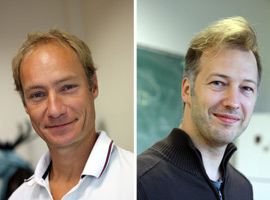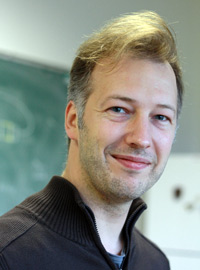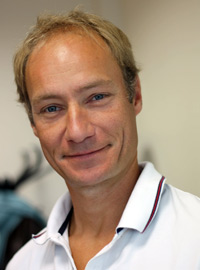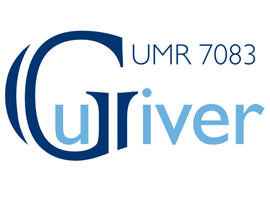
De gauche à droite, Pierre Sens et Florent Krzakala Crédits : ESPCI ParisTech
Pierre Sens et Florent Krzakala are theoretical physicists, both members of the Gulliver Laboratory. This year, they both received an international research grant to develop innovative interdisciplinary projects. From compressed data sensing to cell mobility, a meeting with two scientists who think big in a laboratory specialising in diversity of scales.
Two international funds: a European grant for Florent Krzakala
Florent Krzakala is one of the 2012 recipients of the research grants awarded each year by the European Research Council. “Its sum of one million euros will finance in particular four postdoctorals over the next five years,” explains Florent Krzakala. He first needs to set up this research team. Its aspects? “Interdisciplinary, intercultural, international of course, both very fundamental and very applied, at the crossroads of computing, mathematics and physics.”
Each year, the ERC panel selects individual approaches and proposals “on the sole criterion of the scientific excellence of a researcher and the innovative strength of his or her idea, regardless of nationality, age or field of research”. Each grant is to one person and gives great autonomy to its recipient. In 2011, Sylvain Gigan, teaching researcher at the School, also received an ERC research grant.
This year (2012), Florent Krzakala, armed with encouraging initial scientific results, presented his proposal to the European panel for ERC grants. One panel? More like two! While the portfolio was examined by physicists, he sat the oral before scientists from a different field, namely signal processing. “It’s that my proposal is at the crossroads,” explains Florent Krzakala. “The physicists who examined my initial application decided themselves to call in electronic engineers and mathematicians. As it were, my proposal received double endorsement.”
Pierre Sens supported by the Human Frontier Science Program
Pierre Sens similarly presented a research proposal to the panel of another international organisation: the Human Frontier Science Program (HFSP).
Founded in 1986 on Japanese initiative, this international program finances research into the complex mechanisms of living organisms.
The research is financed at all levels of biological complexity, from biomolecules to interactions between organisms. The grants are awarded for innovative research proposals involving close collaboration between independent teams of researchers, working in different countries and in different disciplines.
Contacts :
florent.krzakala@espci.fr
pierre.sens@espci.fr
elie.raphael@espci.fr
Mission accomplished! Pierre Sens will also benefit from a grant shared with his partners, funding large enough to finance two postdoctorals alongside him for two years. A success which highlights the serious nature of the enterprise: in fact, the HFSP accepts only 10% of proposals put forward. “We combine numerous aspects valued by the panel,” adds Pierre Sens. “In particular, an interdisciplinary international research team including theoretical modelling.”
Next page: Florent Krzakala and his colleagues have solved a problem regarded as insoluble

What do their projects involve? Florent Krzakala and compressed sensing
MP3, JPEG… The whole world knows about data compression: a signal is acquired then compressed. An algorithm thus makes it possible to compress a high-definition photographs into a file whose size is no more than a few hundred kilobytes (kB). During the 2000s a new concept appeared: compressed sensing. Three people opened up this still virgin field: Terry Tao, David Donoho and Emanuel Kandes. They attempted to capture the 100 kB of data essential to the information rather than acquiring the entire signal. Their aim: measuring the useful part before reconstructing it. They found a way of to more precise, faster (less data to acquire) and take up less memory in a machine.
“Their idea - and their discovery - was remarkable,” explains Florent Krzakala. They very quickly found a working application: nuclear magnetic resonance (NMR), the time taken for which is an important limiting factor. Their results made it possible to halve the acquisition time using this method, doubling the availability of scanners for patients, or halving the waiting time for a sometimes vital diagnosis. This is a great achievement.” Yet even though the methods used do extract a relevant part of the signal, they have remained limited. Problem: a threshold effect below which it is not possible to go.
Florent Krzakala and his colleagues enter the stage
Florent Krzakala (ESPCI ParisTech)
Lenka Zdeborova (Saclay – CEA)
Marc Mezard (ENS)
Sun Yifan (Beihang University)
François Sausset (Université Paris Sud)
“With other physicist colleagues, we realise that the problem confronting these specialists in compressed sensing was very similar to the problems of glass transition, which we have studied in physics for years.
Water, for example, crystallises at low temperature but sometimes becomes a supercooled liquid: it remains in the liquid phase even though its temperature is below its solidification point. The situation is the same for compressed data. They remain confined at their minimum values which were not the ones sought. »
– 1999-2002 : Awarded his thesis at Orsay (LPTMS) under the supervision of Prof. Olivier Martin,
– 2002-2004 : Postdoc at the Sapienza University of Rome, in the group led by Pr. Giorgio Parisi,
– 2004 : Maître de conférences at ESPCI ParisTech, in the PCT theoretical physical chemistry group (UMR Gulliver)
– 2008-2010 : Visiting researcher at the Los Alamos National Laboratories (USA),
– 2012 : Receives an ERC grant.
“Using our physicist methods as inspiration, we developed a technique which makes it possible to cross this threshold. That was an enormous surprise in the compressed sensing community: we achieved much better compression levels!”
“At present, one fundamental problem has been resolved. What was not possible before our work now is, and what we have proposed has a strong impact on information theory. Our next objective is implementation in the fields of application and industry, which will be the subject of the work financed by this European grant.”
Next page: How Pierre Sens works with biologists to understand the mobility of cancer cells.

Pierre Sens and cell motility in complex biological systems
The origin of the proposal according to Pierre Sens? “At a meeting in 2010 with a German biologist named Michael Sixt. I heard him mention cell mobility envisaged in a synthetic matrix, i.e. a controllable environment. Unlike many of his colleagues, he considered physical parameters such as friction, elasticity… These are known parameters for physicists, and I understood that there could be a discussion between him and me. It was only later that we simultaneously had the idea of this project. In the meantime, he had talked about it with one of his biologist colleagues, an in vivo specialist, and for my part I had contacted an experimental physicist colleague.” Pierre Sens has set up a multidisciplinary international group consisting of two biologists and two physicists, with very complementary approaches.
The key to success: the desire to talk
"Such a collaboration between specialists in different disciplines is not obvious,” explains Pierre Sens. “The most important thing in my opinion? Having the desire to talk, knowing that each person is perfectly willing to make the effort to understand and be understood. The in vivo biologist works on fish embryos and focuses on the mobility of reproductive cells. Even though we, as physicists, have learnt much in biology since the start of the project, there are a number of parameters which still escape us. The dialogue makes things easier and pushes us forward.”
Pierre Sens, French, working in Paris (theoretical physicist),
Michael Sixt, German, working in Vienna (biologist with in vitro specialisation),
Erez Raz, Israeli, working in Munster (biologist with in vivo specialisation),
Helim Aranda Espinoza, Mexican, conducting research in the USA (experimental physicist).
Unexplained movements
It is necessary to understand that cells move in different ways, depending on their type and the environment in which they develop. Oddly, when a cell is placed flat on a two-dimensional substrate, a front face and a rear face appear. The cell adopts a direction and starts to move. Other cells, observed in a three-dimensional environment, adopt other mobility modes.
– 1996 : Awarded his thesis at the University of Strasbourg,
– 1996-1998 : Postdocs (in the USA and in Israel),
– 1998 : Appointed in charge of research at the CNRS (Strasbourg),
– 2005 : joins the Gulliver Mixed Research Unit in the in the PCT theoretical physical chemistry team at ESPCI ParisTech,
– 2011 : appointed director of research at the CNRS.
How? Why? “We do not know. There must surely be coupling between physical properties and biological decision. We would like to demonstrate this, find the molecular switch and answer the following question: what does a cell do to choose its type of mobility? We are capable of providing physical insight based on a model which the biologists can describe.”
What is the objective of the work financed by the HFSP?
“I want to make a quantitative description based on equations, a sort of “phase diagram”, for cell mobility, which will highlight the importance of physical parameters on the mobility of cells. Last but not least, a further motivation is that this work can help us understand how cancer cells move, and could contribute to the fight against these diseases.”
Next page: A laboratory where interaction between theoreticians and experimentalists promotes discovery.

At the heart of these two projects: the Gulliver Laboratory
Florent Krzakala and Pierre Sens both work within the Gulliver Laboratory, which comprises several research teams. The reason why its name comes from the novel by Jonathan Swift is that the work there happily moves from nanometres to millimetres, from microscopic scale to macroscopic scale.
“The lab has a wealth of resources. I find this a great attraction,” explains Pierre Sens. “There is a dynamism to the laboratory, and in a way the entire lab helped me obtain my grant. We work together, but on different scales. What does the traditional mobility of cells become in microchannels? The question will soon arise, and I know that I can count on my colleagues.” “Yes, at Gulliver we readily share knowledge on problems in mathematics and problems in physics,” offers Florent Krzakala, before adding “Here, we develop projects which make it possible to draw on other fields, to find inspiration...” “That is very important for theoretical physicists like us,” stresses Pierre Sens. “We take care not to lock ourselves up in disciplinary orthodoxy.” “We have to go further,” they both confide.
Directed by Elie Raphaël, the Gulliver Laboratory is a mixed research unit run under the auspices of the CNRS and ESPCI ParisTech. “2012 was a very fruitful year for the lab,” he tells us. “I am delighted with the award of these two grants, which demonstrate international scientific recognition for these two researchers. It will enhance dynamic excellence for the entire laboratory, allowing the development of new subject areas.”
The research carried out at Gulliver essentially relates to soft matter and applied statistical physics, from the development of new theoretical and numerical approaches, through the development of model experiments, to technological applications.
The interaction between theoreticians and experimentalists plays an essential part in the scientific dynamism of Gulliver. Another important mandate of the laboratory is the training of young students.
The laboratory is made up of 4 teams, in which 45 people work every day:
– Theoretical Physical Chemistry, lead by Anthony Maggs,
– Microfluidics, MEMS and Nanostructure, lead by Patrick Tabeling,
– Nanobiophysics, lead by Ulrich Bockelmann,
– Collective Effects & Soft Matter, lead by Olivier Dauchot.
Related articles
The homepage of Pierre Sens
The homepage of Florent Krzakala
Le website of the Gulliver Laboratory
Le website of the ERC
Le website of the HFSP